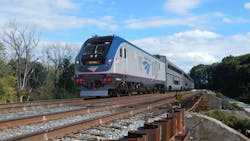Siemens Mobility to supply 75 Charger locomotives to Amtrak
Amtrak and Siemens Mobility have finalized a €744 million (US$847.86 million) contract for 75 Charger diesel-electric locomotives that will replace and supplement Amtrak's aging national network diesel locomotive fleet used on long-distance and state-supported routes.
The locomotives will be manufactured at Siemens Mobility's North American rail manufacturing plant in Sacramento, Calif., and the engines are manufactured by Cummins in its Seymour, Ind., plant, which makes the equipment "Buy American" compliant.
The contract also includes a 20-year Technical Support Spares Supply Agreement (TSSSA). Delivery of the new locomotives will begin in the summer of 2021 and with passenger service beginning later that fall. All locomotives are expected to be in service by 2024.
"We're proud and grateful to expand our relationship with Amtrak, a leader in the U.S. passenger rail transportation, which started nearly a decade ago with locomotives for the Northeast Corridor, connecting two of the U.S.'s largest cities, Washington, D.C., and New York, N.Y. We're confident that the new locomotives will assist Amtrak in its mission to provide safe, world-class, environmentally-responsible technology for its passengers," said Sabrina Soussan, CEO of Siemens Mobility. "The Chargers will provide enhanced passenger experience, greater availability and increased sustainability over the course of their lifecycle, improving Amtrak's long-distance services and operating efficiencies."
The order also solidifies the Charger's popularity among passenger carriers. North America currently has more than 70 Charger locomotives carrying passenger trains nearly 5 million kilometers (3.1 million miles) per year.
Siemens Mobility notes that the Charger locomotives offer the latest safety systems including Crash Energy Management and U.S.-mandated Positive Train Control (PTC). The locomotives are capable of speeds up to 125 mph and the new locomotives feature the QSK95 Cummins 4,400 horsepower-capable 16-cylinder engine, which increase capacity and result in greater availability. The Charger is lower-noise and offers a streamlined design with smoother traction control. Siemens Mobility says the quieter, smoother ride results in an improved experience for both operators and passengers.
The new locomotives are also more environmentally-responsible than their predecessors, providing the latest Tier 4 emissions technology, reducing nitrogen oxide by over 89 percent and particulate matter by 95 percent, compared to Tier 0 standard.
The new locomotives for Amtrak will power trains used on lines that span the United States, both from north-to-south and east-to-west: Auto Train (Washington, DC to Orlando, FL), California Zephyr (Chicago, IL to San Francisco, CA), Capitol Limited (Washington, DC to Chicago, Illinois), Cardinal (New York, New York to Chicago, Illinois), City of New Orleans (Chicago, Illinois to New Orleans, Louisiana), Coast Starlight (Seattle, Washington to Los Angeles, California), Crescent (New York, New York to New Orleans, Louisiana), Empire Builder (Chicago, Illinois to Seattle, Washington), Lake Shore Limited (Boston, Massachusetts to Chicago, Illinois), Palmetto (New York, New York to Savannah, Georgia) Silver Star/Silver Meteor (New York, New York to Miami, Florida), Southwest Chief (Chicago, Illinois to Los Angeles, California), Sunset Limited (New Orleans, Louisiana to Los Angeles, California) and Texas Eagle (Chicago, Illinois to Los Angeles, California via San Antonio, Texas).
About the Author

Mischa Wanek-Libman
Group Editorial Director
Mischa Wanek-Libman is director of communications with Transdev North America. She has more than 20 years of experience working in the transportation industry covering construction projects, engineering challenges, transit and rail operations and best practices.
Wanek-Libman has held top editorial positions at freight rail and public transportation business-to-business publications including as editor-in-chief and editorial director of Mass Transit from 2018-2024. She has been recognized for editorial excellence through her individual work, as well as for collaborative content.
She is an active member of the American Public Transportation Association's Marketing and Communications Committee and served 14 years as a Board Observer on the National Railroad Construction and Maintenance Association (NRC) Board of Directors.
She is a graduate of Drake University in Des Moines, Iowa, where she earned a Bachelor of Arts degree in Journalism and Mass Communication.
